 By Sophie Thomas, Ivory Egg.
By Sophie Thomas, Ivory Egg.
Hopefully summer is on its way, the BBQ gets its annual outing and we pray that we’ll get at least a few days of sunshine to enjoy. Over the past week, temperatures have been rising and this prompts us to think about ventilation. In this article we take a look at MVHR (Mechanical Ventilation Heat Recovery) systems and how KNX integrators can work with these to bring advantages to the entire home.
Ventilation – the Invisible Issue
Indoor air quality (IAQ) has become a hot topic, especially in the workplace, but there is now increasing focus on raising awareness of IAQ in the home. In a European report by EnVIE that was originally published in 2009 and updated in 2011, the UK was ranked as the worst nation for indoor air pollution through water systems, dampness and mould, ventilation and conditioning systems. This statistic is of major concern, as it has been reported that UK citizens spend 90% of their time indoors.
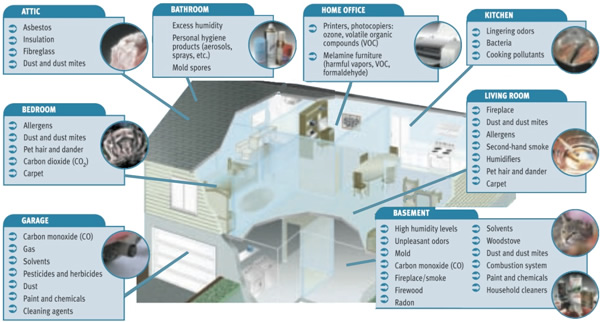
Recent changes to Part L (Conservation of fuel and power) of the UK Building Regulations came into effect in April of this year, and the requirement of a carbon improvement for new homes has been increased by 6% on the original target of 25% set in 2010. As new build homes are becoming more airtight, this places a greater significance on monitoring IAQ and ventilation to avoid aggravating common health conditions such as asthma, and for maximising occupiers’ comfort within the home.
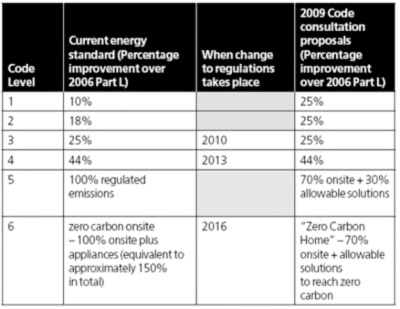
Energy efficiency is a key benefit and motivational driver for installing control platforms such as KNX, especially in Europe. It is widely known that cooling a building is expensive, and the Carbon Trust (a not-for-dividend company that helps organisations reduce their carbon emissions) states that by using air conditioning, a building’s energy consumption and carbon emissions can be increased by up to 100%.
Given the above, there is a specific British and EU standard (BS:EN 779:2012) that supports better indoor air quality by setting minimum efficiency requirements for ventilation filters. Given the improved airtightness of new-build homes as mentioned above, ventilation must be optimised.
With the arrival of the voluntary ‘Code for Sustainable Homes’ in 2010 and the countdown to zero-carbon for homes by 2016 well underway, the impact of ventilation must be explored, but in a way that does not cause other areas of the house to perform less efficiently. For example, addressing the IAQ by simply opening a window, although obvious, is not a helpful solution, as unnecessary ventilation accounts for energy losses between 20-30%. Using a control protocol such as KNX to monitor and control the ventilation can make expensive losses such as this, a thing of the past.
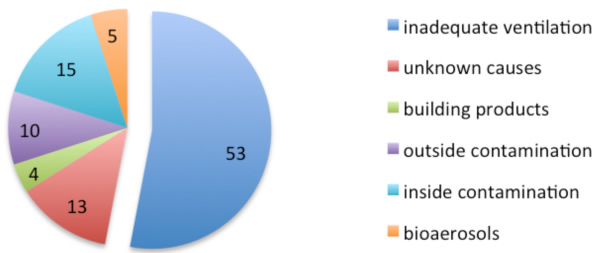
How Can We Manage Ventilation Control?
The objective of ventilation is to positively influence the temperature, air humidity and reduce carbon dioxide (CO2) as well as reduce the concentration of bad odours, smoke and other airborne particles that could be harmful to health.
In new builds, ventilation is normally controlled with a mechanical ventilation and heat recovery (MVHR) unit. With such systems, air is exchanged through mechanical ventilation by a fan, and in areas that are hot or damp such as kitchens and bathrooms, the warmth from the humid air is ‘recovered’ and is redistributed to other areas of the property that are cooler and can benefit from this heat. Fresh air from outside is brought in to increase oxygen levels creating a more comfortable environment.
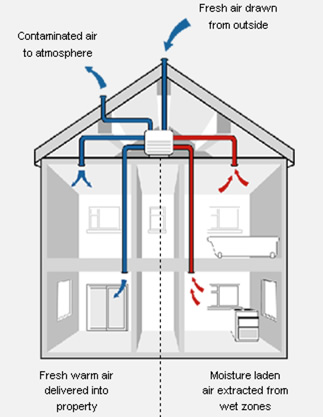
Where Does KNX Come in?
Modern MVHR systems can be integrated into the control plan for a residential building using KNX, but more often than not, can end up being a standalone system. Often this occurs due to the contractual structure of the project as the KNX Integrator can find themselves cut off from the end user and subcontracted to the main contractor.
To make matters worse, an integrator’s work is often done once the main contractor’s work is already signed off. In some respects, it can seem that the KNX integrator has their hands tied, so establishing a solid relationship with the end user at the beginning of the project is vital.
As with any element of building control, the KNX integrator needs control of, or at least an influence over, the system to guarantee an outcome that suits the end-user’s needs. The building of these relationships on-site can be fraught with complications, but on outlining the positives and negatives below, it becomes plain to see that integration of these services is key.
The downsides to the MVHR system remaining separate to KNX are:
• More ‘wall acne’ – i.e. more switches on the wall which do not fit in with the design elements that have been carefully chosen by the architect or client.
* No visualisation – it is not possible to see how the building has been performing, especially when heating and cooling are two of the biggest energy consumers. It is also more difficult to find faults with the system. If you know that the system should be working at a set time and the system is not working, it might not be apparent as to how long this has been happening for, as the end-user might not notice. With a standalone MVHR system, there is also no capability for remote control by the end-user.
• Minimal optimisation – if the MVHR system is standalone, it cannot react or relate to the rest of the house, meaning there could be conflicts that result in energy loss or more energy consumption than necessary, and comfort levels are not being taken into account.
• No flexibility – boost switches for the MVHR are not easily moved and any upgrades to the system may mean adding more additional switches and more wiring which entails more work.
The benefits of controlling the MVHR system with KNX are:
• All of the above negatives are overcome – by using KNX for controlling the MVHR system and integrating all of the household ‘services’, the MVHR can react to a number of other factors such as CO2 levels, humidity, indoor temperature, windows opening or closing and the outside temperature.
• Control of the system is cheap and easy – there will more than likely be spare channels on a switching actuator that is already installed, which can be used for controlling the MVHR unit, and KNX sensors can be relatively inexpensive, if they too are not already installed for another purpose.
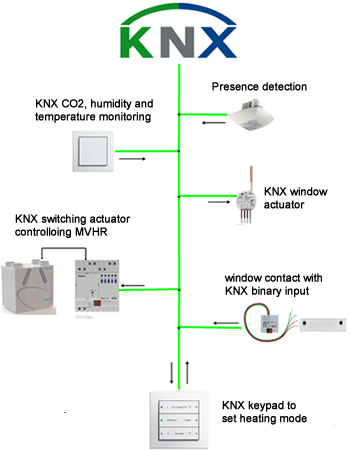
The use of an MVHR system with KNX is a powerful combination. Indeed numerous manufacturers make KNX products such as actuators, CO2 sensors, fan coil actuators and binary outputs that can enhance the energy-saving and health-conserving benefits of such a system.
Examples of KNX Solutions for MVHR
• CO2 Sensing
CO2 levels can be monitored and visualised and appropriate action, such as the boost of a fan, can be triggered automatically. This is a helpful solution for creating a pleasant sleeping environment in a bedroom where it may not be convenient to open a window due to noise or the cold. The use of a CO2 sensor programmed with a maximum CO2 threshold will allow for a boost of airflow, reduction in CO2 and an increase in fresh air and therefore oxygen.
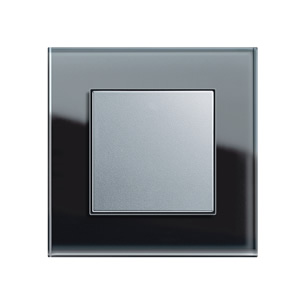
• Humidity Control
Manual control of a fan for ventilation inhibits the potential for optimal IAQ and energy efficiency, whereas using a single KNX product to sense, monitor and reduce the humidity can radically reduce condensation on windows and mirrors in warm and damp environments such as bathrooms and kitchens. Similar to the solution above, a humidity level can be set that will trigger the MVHR into boost mode or increase the fan speed proportionally to maintain the required level of comfort. This solution not only has energy-saving benefits but also reduces excess noise as the fan is only boosted when required.
Lowering humidity levels provides benefits for the building infrastructure too, such as reducing damp.
• Temperature Regulation
MVHR systems move air around the home, a great side effect of which is improved equalisation of temperature throughout the rooms. This is particularly useful in rooms where there is a powerful heat source such as a wood burner or large areas of glass such as windows, meaning high solar gain as this heat is not wasted but is redistributed. Not only is this a benefit in terms of comfort, but also in terms of cost.
Many MVHR systems also include a summer bypass which can be used when the temperature outside is suitable for subtle cooling of the property and cooling is extremely expensive. By using a KNX device, temperature can be monitored during the seasons, and the optimum settings for the system can be achieved all year round.
In addition, KNX can be used in combination with an MVHR system to improve the comfort factor in the home by controlling the internal environment using occupancy sensors, timer and logic control.
Conclusion
A holistic and ‘joined up thinking’ approach in terms of both the control system and the project relationships should be at the centre of home automation, making homes more comfortable and more efficient for the occupier.
The beauty of using KNX is that sensing CO2, humidity and temperature can all be achieved using just one product. Some may argue that many newer properties already have MVHR units capable of some of this functionality, however KNX devices are often already installed in the job or, if not, are relatively inexpensive, and could even be placed in every room. This allows for the home to be seen as a whole and every room monitored and controlled to be kept as comfortable and efficient as possible.
Sophie Thomas is the Marketing and Events Manager at Ivory Egg (UK) Ltd, a supplier of leading KNX products and provider of KNX training courses.
You are welcome to comment on this article below.












